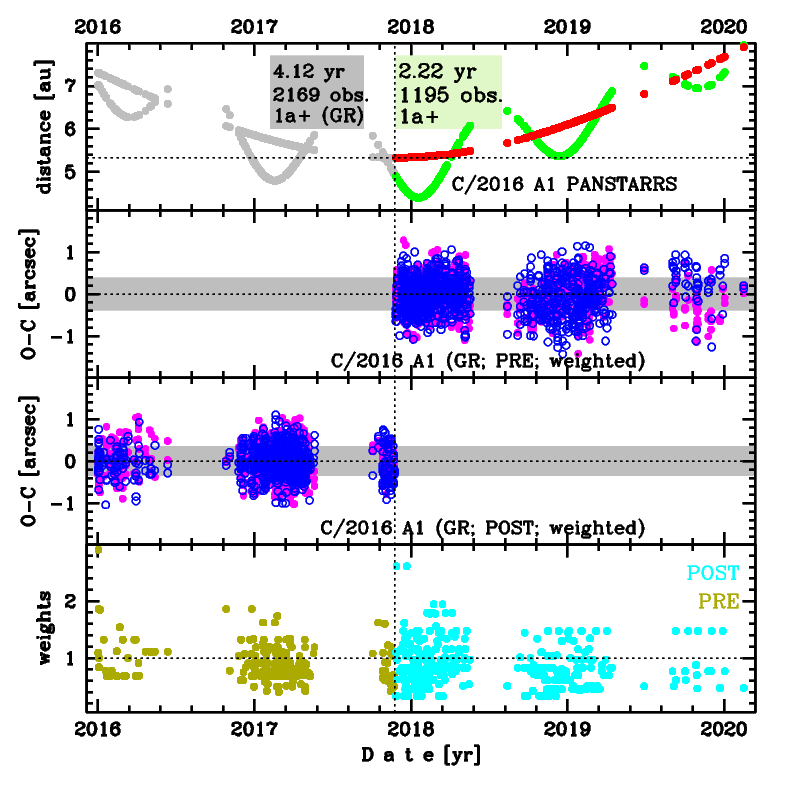C/2016 A1 PANSTARRS
more info
Comet C/2016 A1 was discovered on 1 January 2016 with Pan-STARRS 1 telescope (Haleakala), that is about almost 2 yr before its perihelion passage, and was next observed until 15 February 2020.
Comet had its closest approach to the Earth on 17 January 2018 (4.397 au); about 2 months after its perihelion passage.
Solutions given here are based on data spanning over 4.12 yr in a range of heliocentric distances: 7.31 au 5.328 au (perihelion) – 7.90 au.
This Oort spike comet suffers small planetary perturbations during its passage through the planetary system that lead to a more tight future orbit (see future barycentric orbit).
See also Królikowska and Dones 2023.
Comet had its closest approach to the Earth on 17 January 2018 (4.397 au); about 2 months after its perihelion passage.
Solutions given here are based on data spanning over 4.12 yr in a range of heliocentric distances: 7.31 au 5.328 au (perihelion) – 7.90 au.
This Oort spike comet suffers small planetary perturbations during its passage through the planetary system that lead to a more tight future orbit (see future barycentric orbit).
See also Królikowska and Dones 2023.
| solution description | ||
|---|---|---|
| number of observations | 1195 | |
| data interval | 2017 11 26 – 2020 02 15 | |
| data arc selection | data generally limited to post-perihelion (POS) | |
| range of heliocentric distances | 5.33 au – 7.9au | |
| detectability of NG effects in the comet's motion | NG effects not determinable | |
| type of model of motion | GR - gravitational orbit | |
| data weighting | YES | |
| number of residuals | 3212 | |
| RMS [arcseconds] | 0.39 | |
| orbit quality class | 1a+ | |
| next orbit statistics, both Galactic and stellar perturbations were taken into account | ||
|---|---|---|
| no. of returning VCs in the swarm | 5001 | * |
| no. of escaping VCs in the swarm | 0 | |
| no. of hyperbolas among escaping VCs in the swarm | 0 | |
| next reciprocal semi-major axis [10-6 au-1] | 130.07 – 130.74 – 131.41 | |
| next perihelion distance [au] | 5.34034 – 5.34083 – 5.34135 | |
| next aphelion distance [103 au] | 15.21 – 15.29 – 15.37 | |
| time interval to next perihelion [Myr] | 0.6631 – 0.6682 – 0.6733 | |
| percentage of VCs with qnext < 10 | 100 | |

Upper panel: Time distribution of positional observations with corresponding heliocentric (red curve) and geocentric (green curve) distance at which they were taken. The horizontal dotted line shows the perihelion distance for a given comet whereas vertical dotted line — the moment of perihelion passage.
Middle panel(s): O-C diagram for a given solution (sometimes in comparison to another solution available in CODE), where residuals in right ascension are shown using magenta dots and in declination by blue open circles.
Lowest panel: Relative weights for a given data set(s).
Middle panel(s): O-C diagram for a given solution (sometimes in comparison to another solution available in CODE), where residuals in right ascension are shown using magenta dots and in declination by blue open circles.
Lowest panel: Relative weights for a given data set(s).
| next_g orbit statistics, here only the Galactic tide has been included | ||
|---|---|---|
| no. of returning VCs in the swarm | 5001 | * |
| no. of escaping VCs in the swarm | 0 | |
| no. of hyperbolas among escaping VCs in the swarm | 0 | |
| next reciprocal semi-major axis [10-6 au-1] | 130.06 – 130.73 – 131.39 | |
| next perihelion distance [au] | 5.35588 – 5.35638 – 5.35689 | |
| next aphelion distance [103 au] | 15.22 – 15.29 – 15.37 | |
| time interval to next perihelion [Myr] | 0.6632 – 0.6683 – 0.6734 | |
| percentage of VCs with qnext < 10 | 100 | |